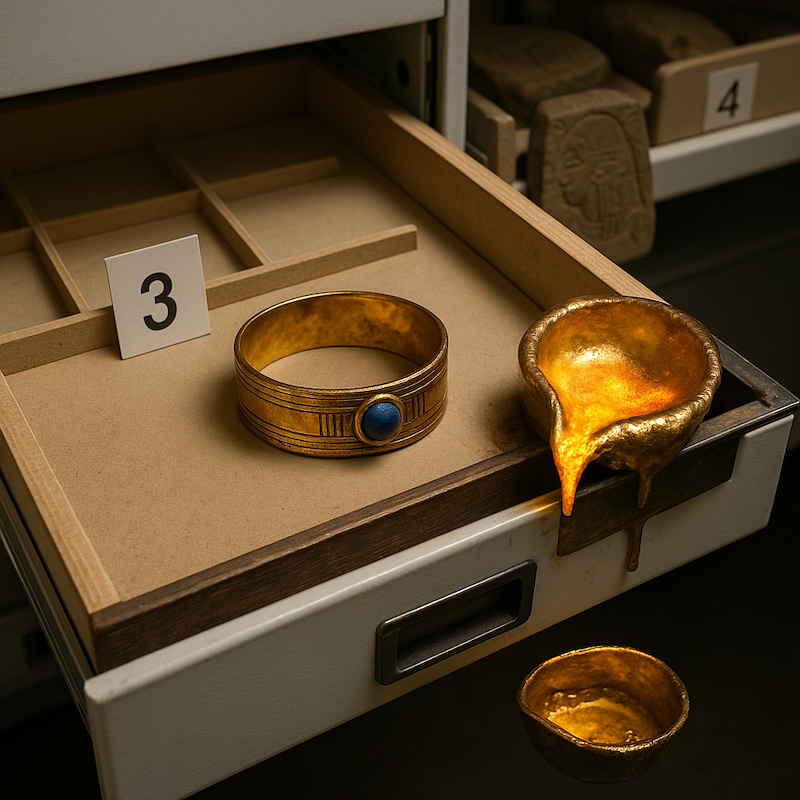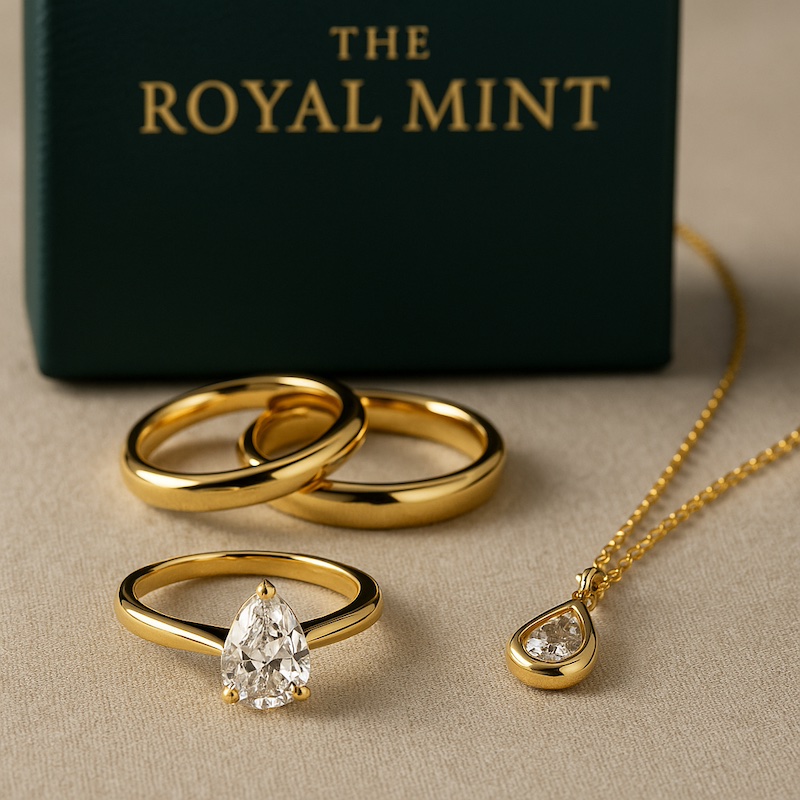Imagine trading a 3,000-year-old royal treasure for roughly the price of a mid-range modern bullion coin.
That’s essentially what happened in the recent Egyptian gold bracelet theft, where a priceless artifact belonging to Pharaoh Amenemope was stolen from the Egyptian Museum in Cairo, sold through a chain of dealers for around $4,000, and finally melted down for scrap gold.
For coin collectors, numismatists, and investors, this isn’t just a tabloid-ready crime story. It’s a powerful, real-world case study in intrinsic value vs. numismatic and cultural value, the risks of the illicit antiquities market, and the responsibilities that come with handling historic metal.
TL;DR – What Coin People Should Take Away
- A gold bracelet of Pharaoh Amenemope (21st Dynasty, ca. 10th century BC) was stolen from the Egyptian Museum, sold for roughly 190,000 Egyptian pounds (~$4,000), and melted down.
- The piece had enormous archaeological and cultural value, far beyond its melt price.
- Ancient Egyptians saw gold as the “flesh of the gods”, and lapis lazuli as the hair of the gods, making the bracelet a religious object, not just jewelry.
- The case shows how illicit antiquities trafficking destroys history while generating relatively modest criminal profit in many instances.
- For collectors, the big lessons are: provenance matters, avoid unprovenanced artifacts, and never reduce historic pieces—coins or otherwise—to metal value alone.
Inside the Egyptian Gold Bracelet Theft
The story reads like a cautionary tale written specifically for the numismatic community.
According to Egyptian authorities and multiple international reports, the bracelet was removed from a restoration lab at the Egyptian Museum in Cairo in early September 2025, while curators were preparing artifacts for loan to a museum in Rome.
Investigators allege the following chain of events:
- A museum restoration specialist quietly lifted the bracelet from a safe.
- He sold it to a silver trader, who passed it on to a gold jeweler.
- The jeweler sold it again to a gold smelter, who melted the bracelet together with other items.
- In total, intermediaries paid the thief around 190,000 Egyptian pounds, equivalent to roughly $3,700–$4,000 USD, depending on the rate used.
- Four suspects were arrested; the loss of the artifact triggered public outrage in Egypt and international criticism of museum security.
From a purely financial standpoint, the thief effectively received near melt value for the weight of the gold, sacrificing any premium for artistry, age, and royal provenance—and of course facing prison in the process.
From a cultural standpoint, the world lost an irreplaceable piece of pharaonic history.
Why the Amenemope Bracelet Was Priceless
A royal object from a rare intact tomb
The bracelet belonged to Pharaoh Amenemope, a ruler of Egypt’s 21st Dynasty during the Third Intermediate Period(often dated around 993–984 BC).
His tomb at Tanis was one of the extraordinarily rare undisturbed royal burials discovered in the 20th century, excavated by French archaeologist Pierre Montet in 1939–40. These finds—alongside those of Psusennes I and Shoshenq II—gave scholars a near pristine glimpse into high-status funerary practice after the New Kingdom.
The stolen bracelet was:
- A solid gold band
- Set with at least one spherical lapis lazuli bead
- Part of Amenemope’s intricate burial assemblage, which also included a famous gold funerary mask.
One Egyptologist quoted by Smithsonian described the bracelet as “not the most beautiful” object aesthetically, but “scientifically… one of the most interesting,” because of what it teaches about craft, symbolism, and context in Amenemope’s reign.
In other words, this piece was data as well as decoration—evidence for how gold and gemstones were used in royal ideology.
Gold as “flesh of the gods,” lapis as “hair of the gods”
To ancient Egyptians, gold’s importance was deeply spiritual. Scholarly and popular syntheses alike emphasize that gold was revered as the “flesh of the gods,” particularly the sun god Ra, thanks to its untarnishing, sun-like sheen.
Lapis lazuli carried similar weight. Egyptological sources describe lapis as associated with the hair of the gods, complementing gold (“flesh”) and silver (“bones”) in a sacred trinity of materials.
So this bracelet was not a mere fashion accessory; it was a miniature theology lesson in metal and stone:
- Gold band → divine flesh and immortality
- Lapis bead → divine hair and cosmic power
- Royal ownership → the pharaoh as living embodiment of the gods
Melting it down reduced that entire symbolic system to a generic blob of bullion—and permanently erased its archaeological context.
Ancient Egyptian Gold, Value Systems, and “Proto-Money”
Collectors often think of value in terms of face value, bullion value, and numismatic premium. In Amenemope’s time, the categories were different but the tension between metal weight and cultural meaning already existed.
No gold coins, but gold had economic weight
Ancient Egyptians did not issue gold coinage in the way later Greeks and Romans did. Instead, they used:
- Barter and commodity exchange, with grain (especially barley) playing a central role.
- Gold and silver by weight, acting as units of account in transactions and valuations.
The main weight unit for precious metals was the deben, usually around 90–95 grams in the New Kingdom according to Egyptological research and reference works like Britannica.
Prices could be expressed as fractions of a gold or silver deben—for example, a tool might cost ¼ deben of gold.
Instead of coins, people used:
- Ingots and rings of metal
- Weighted pieces that could be measured on scales
The Amenemope bracelet, however, was never meant to circulate. It belonged to the separate realm of sacred and royal objects, yet its fate in 2025 was to be treated exactly like an anonymous ingot.
That is the core irony: the thief and intermediaries reduced a highly specific, fully documented royal object to what an ancient Egyptian farmer might have recognized—a bit of weighed metal denominated in value only.
What the Egyptian Gold Bracelet Theft Teaches Modern Coin Collectors
For numismatists, the Amenemope case is a vivid, almost brutal illustration of a principle we talk about constantly:
Intrinsic metal value is only one layer of what a coin or artifact is worth.
Intrinsic vs. numismatic vs. cultural value
Consider a simplified comparison:
| Item | Metal Value | Numismatic Value | Cultural / Scientific Value |
|---|---|---|---|
| Generic 1 oz modern bullion coin | High | Low–Moderate | Low |
| Key-date proof gold coin with low mintage | High | High | Moderate |
| 3,000-year-old royal bracelet with full context | High | Extremely high | Extraordinary |
The thief treated the bracelet as if it were in the first category, when in reality it occupied the third.
Coin collectors face a milder but parallel temptation:
- Cleaning a coin “for shine,” destroying original surfaces and value
- Melting older or damaged coins for bullion without understanding rarity
- Buying unprovenanced ancient pieces because “the price is good,” potentially supporting looting
The bracelet story pushes us to ask, Am I seeing the whole picture of this object’s value, or just the metal?
The Illicit Antiquities Trade: A Global Problem Collectors Can Influence
The Amenemope bracelet is one high-profile casualty of a much larger problem: the illicit trade in antiquities and cultural property.
International bodies note:
- Profits from illicit antiquities are estimated in the hundreds of millions to several billion dollars annually, though precise figures are hard to pin down.
- UNESCO and the UN describe trafficking in cultural property as a serious transnational crime that robs communities of their history and can finance organized crime and even terrorism.
In Egypt specifically, authorities have faced repeated incidents of artifact theft, looting, and smuggling, from museum heists to illicit digs.
As collectors, we are part of the demand side of that equation. Even if we focus on coins rather than large artifacts, the same networks often handle both.
Practical risks for buyers
Buying unprovenanced antiquities or ancient coins from questionable sources creates multiple risks:
- Legal risk – items may be subject to seizure or repatriation if shown to be looted or stolen.
- Financial risk – if confiscated, you may lose both the object and the money paid.
- Ethical and reputational risk – dealing in tainted objects can damage your standing as a collector, dealer, or professional.
- Market risk – illicit goods distort price signals and undermine trust in the entire antiquities and ancient-coin market.
Best Practices: How Coin Collectors and Dealers Can Respond
1. Make provenance non-negotiable
For ancient coins and artifacts, insist on:
- Documented ownership history
- Copies of invoices and export permits where relevant
- Reputable auction or dealer records
If a seller cannot provide any provenance or dismisses the question, treat that as a red flag.
2. Separate bullion buying from antiquities collecting
If your goal is primarily metal exposure, buy:
- Modern bullion coins and bars from the major mints
- Products with clear legal status and no cultural-heritage issues
Reserve ancient pieces and artifacts for a separate, well-researched, provenance-conscious budget.
3. Work with respected professionals
- Use dealers who are members of recognized trade associations and follow ethical codes regarding cultural property.
- When in doubt, consult specialized numismatic appraisers or attorneys familiar with heritage law before making major purchases.
4. Support legitimate heritage protection efforts
- Pay attention to museum and academic warnings about stolen items.
- Familiarize yourself with international observances such as UNESCO’s International Day against Illicit Trafficking in Cultural Property (14 November).
By aligning our collecting habits with these principles, we help ensure that future Amenemope-style tragedies are less likely.
Internal Linking Ideas (for Website Publishers)
To deepen user engagement and strengthen SEO, you could internally link this article to:
- A guide to evaluating intrinsic vs numismatic value in coins
- An explainer on provenance and documentation for ancient coins and artifacts
- A feature on ancient Egyptian gold and its symbolism
- A legal explainer on U.S. and international laws governing cultural property and antiquities
- Case studies of famous recovered or repatriated coins and artifacts
FAQ: Egyptian Gold Bracelet Theft and What It Means for Collectors
1. Why was the Amenemope bracelet melted instead of sold as an artifact?
Selling a high-profile stolen artifact on the open market is extremely risky. Egyptian law allows for life imprisonmentfor smuggling antiquities, and a 3,000-year-old royal bracelet would be instantly recognizable. By melting it, the thieves hoped to convert it into anonymous bullion, easier to sell locally and abroad—though they received only a fraction of its real value.
2. How does this relate to coin collecting?
The key lesson is that context and history are irreplaceable. Just as cleaning a rare coin or melting a low-mintage piece destroys its premium, melting a royal bracelet destroyed millennia of cultural information. The story is an extreme version of a mistake collectors can make in smaller ways every day.
3. Are all ancient coins at risk of being illicit?
No—but a non-trivial portion of the market may include items that were illegally excavated or exported. Scholars and organizations like UNESCO stress that the absence of paperwork is a major warning sign. Collectors should favor coins with established provenance, especially for high-value pieces.
4. What should I do if I suspect a coin or artifact I own is illicit?
Consult a knowledgeable attorney or heritage-law specialist and a reputable museum or academic expert. In some cases, voluntary disclosure or repatriation can mitigate legal and reputational damage. Do not try to quietly sell or export the object—that can compound potential liability.
5. Does this mean collectors should avoid ancient coins entirely?
Not necessarily. Ancient-coin collecting can be a rich and legitimate pursuit when approached ethically. The Amenemope bracelet theft simply underscores the importance of:
- Buying from reputable sources
- Demanding provenance
- Recognizing that you are a steward of history, not just a speculator in metal.
Conclusion: A Tragic Reminder of Our Role as Stewards
The Egyptian gold bracelet theft is, at heart, a story about a disastrous mispricing of value: a thief trading three millennia of royal history for a few thousand dollars, and a smelter reducing divine symbolism to a lump of anonymous metal.
For coin collectors, investors, and industry professionals, the takeaway is clear:
- Never see a historic piece as “just gold” or “just silver.”
- Treat provenance and legality as essential parts of value, not afterthoughts.
- Remember that every ancient coin, medal, or artifact you handle is part of a much longer story than your own portfolio.
If this case has you rethinking your approach, consider taking one concrete step today—review a recent purchase for provenance, talk to a trusted dealer about best practices, or educate a fellow collector. Small decisions, made consistently, are how we prevent the next Amenemope-style loss.
Meta Description
A 3,000-year-old pharaoh’s bracelet was stolen and melted for gold. Discover what this Egyptian gold bracelet theft teaches modern coin collectors and investors.








